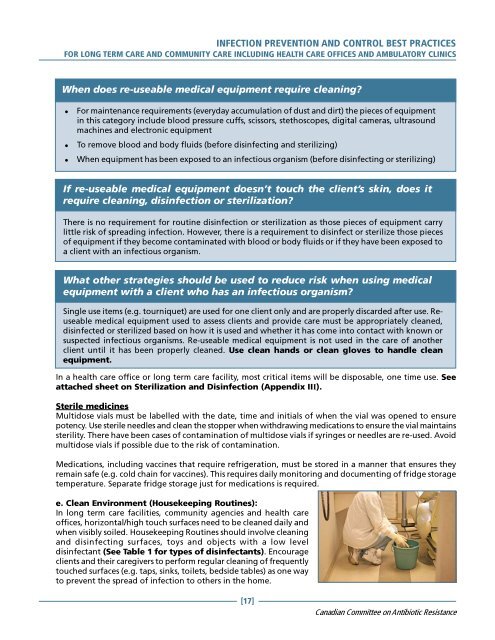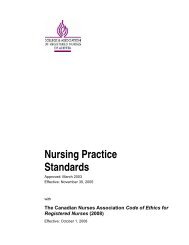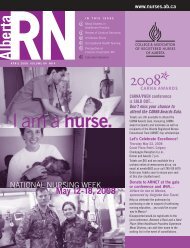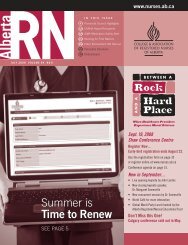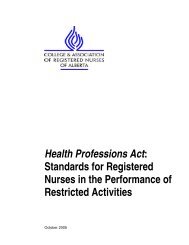Infection Prevention and Control Best Practices - College ...
Infection Prevention and Control Best Practices - College ...
Infection Prevention and Control Best Practices - College ...
Create successful ePaper yourself
Turn your PDF publications into a flip-book with our unique Google optimized e-Paper software.
INFECTION PREVENTION AND CONTROL BEST PRACTICES<br />
FOR LONG TERM CARE AND COMMUNITY CARE INCLUDING HEALTH CARE OFFICES AND AMBULATORY CLINICS<br />
When does re-useable medical equipment require cleaning?<br />
� For maintenance requirements (everyday accumulation of dust <strong>and</strong> dirt) the pieces of equipment<br />
in this category include blood pressure cuffs, scissors, stethoscopes, digital cameras, ultrasound<br />
machines <strong>and</strong> electronic equipment<br />
� To remove blood <strong>and</strong> body fluids (before disinfecting <strong>and</strong> sterilizing)<br />
� When equipment has been exposed to an infectious organism (before disinfecting or sterilizing)<br />
If re-useable medical equipment doesn’t touch the client’s skin, does it<br />
require cleaning, disinfection or sterilization?<br />
There is no requirement for routine disinfection or sterilization as those pieces of equipment carry<br />
little risk of spreading infection. However, there is a requirement to disinfect or sterilize those pieces<br />
of equipment if they become contaminated with blood or body fluids or if they have been exposed to<br />
a client with an infectious organism.<br />
What other strategies should be used to reduce risk when using medical<br />
equipment with a client who has an infectious organism?<br />
Single use items (e.g. tourniquet) are used for one client only <strong>and</strong> are properly discarded after use. Reuseable<br />
medical equipment used to assess clients <strong>and</strong> provide care must be appropriately cleaned,<br />
disinfected or sterilized based on how it is used <strong>and</strong> whether it has come into contact with known or<br />
suspected infectious organisms. Re-useable medical equipment is not used in the care of another<br />
client until it has been properly cleaned. Use clean h<strong>and</strong>s or clean gloves to h<strong>and</strong>le clean<br />
equipment.<br />
In a health care office or long term care facility, most critical items will be disposable, one time use. See<br />
attached sheet on Sterilization <strong>and</strong> Disinfection (Appendix III).<br />
Sterile medicines<br />
Multidose vials must be labelled with the date, time <strong>and</strong> initials of when the vial was opened to ensure<br />
potency. Use sterile needles <strong>and</strong> clean the stopper when withdrawing medications to ensure the vial maintains<br />
sterility. There have been cases of contamination of multidose vials if syringes or needles are re-used. Avoid<br />
multidose vials if possible due to the risk of contamination.<br />
Medications, including vaccines that require refrigeration, must be stored in a manner that ensures they<br />
remain safe (e.g. cold chain for vaccines). This requires daily monitoring <strong>and</strong> documenting of fridge storage<br />
temperature. Separate fridge storage just for medications is required.<br />
e. Clean Environment (Housekeeping Routines):<br />
In long term care facilities, community agencies <strong>and</strong> health care<br />
offices, horizontal/high touch surfaces need to be cleaned daily <strong>and</strong><br />
when visibly soiled. Housekeeping Routines should involve cleaning<br />
<strong>and</strong> disinfecting surfaces, toys <strong>and</strong> objects with a low level<br />
disinfectant (See Table 1 for types of disinfectants). Encourage<br />
clients <strong>and</strong> their caregivers to perform regular cleaning of frequently<br />
touched surfaces (e.g. taps, sinks, toilets, bedside tables) as one way<br />
to prevent the spread of infection to others in the home.<br />
[17]<br />
Canadian Committee on Antibiotic Resistance


